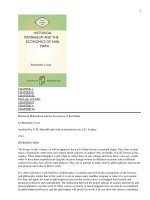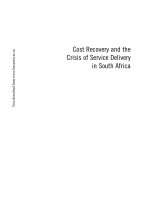Occupy online facebook and the spread of occupy wall street
Bạn đang xem bản rút gọn của tài liệu. Xem và tải ngay bản đầy đủ của tài liệu tại đây (941.99 KB, 20 trang )
Occupy
Online:
Facebook
and
the
Spread
of
Occupy
Wall
Street
Neal
Caren
Sarah
Gaby
University
of
North
Carolina,
Chapel
Hill
October
24,
2011
Electroniccopy
copy available
available at:
Electronic
at: /> />
Occupy
Online:
and
the
Spread
of
Occupy
Wall
Street
Summary
Since
Occupy
Wall
Street
began
in
New
York
City
on
September
17th,
the
movement
has
spread
offline
to
hundreds
of
locations
around
the
globe.
Social
networking
sites
have
been
critical
for
linking
potential
supporters
and
distributing
information.
In
addition
to
pages
on
the
Wall
Street
Occupation,
more
than
400
unique
pages
have
been
established
in
order
to
spread
the
movement
across
the
US,
including
at
least
one
page
in
each
of
the
50
states.
These
pages
facilitate
the
creation
of
local
encampments
and
the
organization
of
protests
and
marches
to
oppose
the
existing
economic
and
political
system.
Based
on
data
acquired
from
Facebook,
we
find
that
Occupy
groups
have
recruited
over
170,000
active
users
and
more
than
1.4
million
“likes”
in
support
of
Occupations.
By
October
22,
pages
related
to
the
Wall
Street
Occupation
had
accumulated
more
than
390,000
“likes”,
while
almost
twice
that
number,
more
than
770,000,
have
been
expressed
for
the
324
local
sites.
Most
new
Occupation
pages
were
started
between
September
23th
and
October
5th.
On
October
11th,
occupy
activity
on
peaked
with
73,812
posts
and
comments
to
an
occupy
page
in
a
day.
By
October
22nd,
there
had
been
1,170,626
total
posts
or
comments
associated
with
Occupation
pages.
The
density
of
activism
is
highest
in
college
towns
and
in
state
capitals.
Major
uses
for
within
the
movement
include
the
recruitment
of
people
and
resources
to
local
occupations;
information
sharing
and
story
telling;
and
across-‐group
exchanges.
While
the
focus
of
Occupy
Wall
Street
is
on
mobilizing
individual’s
offline,
online
activities
greatly
facilitate
these
efforts.
Electroniccopy
copy available
available at:
Electronic
at: /> />
Occupy
Wall
Street
-‐
Overview1
On
July
13,
2011,
Adbusters,
a
Canadian
not-‐for-‐profit
magazine,
asked,
“Are
you
ready
for
a
Tahrir
moment?
On
Sept.
17,
flood
into
lower
Manhattan,
set
up
tents,
kitchens,
peaceful
barricades
and
occupy
Wall
Street.”
Tactically,
the
movement
drew
inspiration
from
both
the
Arab
Spring
and
the
anti-‐globalization
movement.
Adbusters
pointed
the
finger
at
the
“greatest
corrupter
of
our
democracy;
Wall
Street,
the
financial
Gomorrah
of
America.”2
On
August
8,
just
shy
of
one
month
after
Adbusters
launched
the
campaign,
a
page
for
Occupy
Wall
Street
was
established.
The
first
actions
on
the
page
called
supporters
to
a
general
assembly
(GA),
a
tactical
form
of
participatory
democracy
that
would
be
one
of
the
signature
elements
of
local
Occupations.
The
New
York
General
Assembly
describes
itself
as
the
following:
“...an
open,
participatory
and
horizontally
organized
process
through
which
we
are
building
the
capacity
to
constitute
ourselves
in
public
as
autonomous
collective
forces
within
and
against
the
constant
crises
of
our
times.”3
On
September
17th,
hundreds
of
activists
gathered
in
lower
Manhattan.
The
movement
received
little
national
coverage
until
September
24th,
when
YouTube
footage
of
a
protester
being
pepper
sprayed
by
a
New
York
City
police
officer
went
viral.
The
movement
became
an
even
larger
media
presence
with
the
arrest
of
more
than
700
people
on
the
Brooklyn
Bridge
on
October
1st,
following
a
large
rally
and
march.
Organizations
such
as
Occupy
Together
and
Occupy
Colleges
were
formed
to
spread
the
movement
nationally.
The
movement
is
made
unique
by
its
sustained
visibility.
In
cities
and
towns
across
the
United
States,
and
internationally,
groups
are
setting
up
organizing
rallies
and
establishing
encampments.
In
some
locations,
these
consist
of
tents,
food
stations,
and
entire
outdoor
communities
dedicated
to
remaining
in
“occupation”
of
a
given
location.
In
other
cities,
encampments
may
be
groups
of
individuals
who,
limited
by
the
rules
and
laws
in
their
towns
or
cities
sleep
on
sidewalks,
sit
in
grassy
areas,
or
even
stand
in
groups
all
night.
Banners,
signs,
and
printed
material
often
make
the
groups
move
visible.
Although
the
movement
began
on
Wall
Street
with
a
focus
on
the
financial
sector,
the
lack
of
specific
demands
enabled
local
movements
to
adopt
messages
personalized
to
their
experience
or
location
beyond
the
focal
Wall
Street,
with
the
movement
being
framed
as
belonging
to
all
those
outside
of
the
top
1%
of
wealth
holders
in
the
United
States,
as
made
clear
by
the
dominant
movement
slogan,
“We
are
the
99%.”
This
flexible
frame,
broad
identity,
and
the
availability
of
replicable
tactics
such
as
general
assemblies
and
encampments
have
added
to
the
spread
of
the
Occupy
movement.
The
Occupy
Movement
Online
OWS
is
primarily
an
off-‐line
activity.
Activists
come
together
in
central
city
locations
for
hours
or
days.
Decision-‐making
happens
here
in
regularly
scheduled
general
assembly
meetings.
This
face-‐to-‐face
participatory
democracy
embodies
one
of
the
core
values
of
the
movement.
Notwithstanding,
OWS
has
been
an
active
presence
on
major
social
media
platforms
using
sites
such
as
Facebook,
Twitter,
Youtube,
Meetup,
Livestream
and
individual
websites.
Our
analysis
suggests
that
is
the
most
prominent
social
1
Map
on
front
page
created
at
2 />3 />
Electronic copy available at: />
networking
site
associated
with
the
movement.
For
instance,
while
occupytogether.org
has
13,868,
“occupiers,”
the
page
for
occupy
Boston
has
28,020
likes
alone.
The
number
of
followers
on
also
far
outnumber
that
on
twitter,
with
only
17,760
followers
subscribed
to
the
occupy
Boston
feed,
and
5
Meetup
members.
The
largest
of
the
Meetups,
Denver,
had
227
occupiers,
which
is
fewer
than
7%
of
the
number
of
people
who
used
the
Occupy
Denver
page.
Many
movement
groups
also
have
websites,
such
as
occupyboston.com
and
occupychi.org.
Occupy
Wall
Street
usage
appears
heavily
driven
by
ongoing
events.
According
to
usage
data
from
Trendistic,
as
shown
in
Figure
1,
the
periods
of
heaviest
usage
of
the
two
most
common
hashtags
associated
with
OWS,
#OWS
and
#Occupywallstreet,
peaked
on
October
1st,
when
over
700
individuals
were
arrested
on
the
Brooklyn
Bridge,
and
on
October
15th,
when
hundreds
of
protests
were
held
around
the
globe,
including
a
party
in
New
York’s
Times
Square.
Figure
1.
trends
in
national
Occupy
hashtags,
based
on
data
from
Trendistic.
Trends
in
hashtags
for
local
OWS
groups
show
even
greater
swings.
Usage
of
these
hashtags
is
strongly
associated
with
police-‐protester
interactions,
such
as
the
arrest
of
more
than
a
hundred
at
the
Occupy
Boston
encampment
on
the
evening
of
October
10th
and
the
arrest
of
23
people
at
the
Occupy
Denver
encampment
on
October
14th.
Like
the
movement’s
first
national
spike,
on
September
24th,
associated
with
New
York
City
police
officers
using
pepper
spray,
these
dramatic,
newsworthy
events
often
involve
compelling
video
footage,
which
can
be
easily
linked
to
in
a
tweet.
Tweets
are
fleeting,
and
the
interface
is
designed
to
highlight
current
news
rather
than
static
information.
As
such,
can
be
critical
for
helping
a
movement
during
events
and
to
spread
word
quickly
and
widely,
but
is
unlikely
to
be
the
only
web
presence
for
a
sustained
movement,
such
as
OWS.
Occupying
Media
accounts
have
emphasized
the
role
of
in
the
Occupy
movement4,
and
a
survey
of
visitors
to
occupywallstreet.org
found
that
it
was
the
social
networking
site
most
used
by
protesters5.
In
order
to
explore
the
extent
and
type
of
Occupy
group
usage
on
Facebook,
we
created
a
list
of
all
pages
related
to
the
movement.
Using
published
lists6
and
searches
for
key
terms,
we
identified
408
pages
on
US
Occupations.
We
4 />5 />6 />
US-‐solidarity-‐events-‐and-‐Facebook%C2%A0pages;
/>
Electronic copy available at: />
categorized
each
of
the
pages
based
on
one
of
four
areas
of
focus:
the
Wall
Street
Occupation
(e.g.
Occupy
Wall
St.);
efforts
to
symbolically
occupy
national
institutions
(e.g.
Occupy
the
Media)
or
spread
Occupy
Wall
Street
nationally
(e.g.
Occupy
Together);
state
or
regional
Occupy
coordination
pages
(e.g.
Occupy
Florida);
or
pages
on
specific
local
occupations
(e.g.
Occupy
Denver).
We
identified
13
Wall
Street
pages;
38
national
pages;
33
state
or
regional
pages;
and
324
local
pages.
There
are
likely
to
be
smaller
pages
that
we
did
not
account
for7
and
we
were
not
able
to
collect
all
comments
on
19
posts,
each
of
which
had
more
than
500
comments.
For
each
page,
we
downloaded
all
posts
and
comments
that
had
been
made
on
the
page
between
the
day
that
the
page
was
created
and
October
22nd,
2011.
From
this
we
are
able
to
identify
the
number
of
likes
for
each
post
and
the
number,
text,
content
and
author
of
each
post
and
post
comment.
We
are
therefore
able
to
identify
the
amount
of
activity
on
each
page,
and
cumulatively,
by
summing
the
number
of
posts
and
comments.
We
are
also
able
to
identify
the
cumulative
number
of
users
posting
across
Occupy
pages,
including
the
date
of
their
first
posting
on
any
Occupy
page.
Only
data
from
public
Occupy
pages
were
used
in
this
study.
The
majority
of
activity
happens
on
personal
pages,
and
we
are
not
able
to
observe
this
information
because
of
privacy
restrictions.
For
example,
if
an
individual
posted
a
status
update
that
she
was
attending
an
Occupy
Durham
event,
we
would
not
be
able
to
capture
that
activity.
If
she
posted
this
on
the
Occupy
Durham
page,
however,
we
would
have
collected
the
information.
Thus,
the
estimates
that
we
provide
here
underestimate
the
extent
to
which
users
have
been
engaged
with
the
Occupy
Wall
Street
movement.
More
than
400
US
Occupation
related
pages
have
been
established.
Table
1
identifies
the
top
50
pages
based
on
the
number
of
individuals
who
had
either
posted
or
commented
on
the
page.
The
largest
of
these
is
the
page
associated
with
the
original
Wall
Street
Occupation.
The
first
posts
on
this
page
date
to
August
8th,
and
since
then,
266,044
people
have
“liked”
the
page,
with
more
than
44,000
individuals
contributing
over
253,000
posts
or
comments.
The
second
largest
page
in
terms
of
likes
and
users
is
Occupy
Together,
associated
with
an
effort
to
spread
the
occupation
tactic
across
the
country.
This
group
encourages
users
to
join
or
start
local
occupations
using
meetup.com,
and
as
of
October
19th,
the
meetup.com/occupytogether/
had
15,942
registered
occupiers
in
1,996
cities
across
the
globe.
Of
the
50
largest
pages
in
terms
of
users,
40
of
them
are
associated
with
specific
local
occupations.
The
largest
of
the
local
Occupy
pages,
in
terms
of
users,
was
Occupy
Boston,
with
more
than
9,000
users,
followed
by
Los
Angeles,
Philadelphia,
and
Seattle,
and
a
total
of
42
local
pages
have
more
than
1,000
users
by
October
22nd.
7Please
contact
the
first
author
at
if
you
know
of
any
pages
that
we
overlooked.
Electronic copy available at: />
Figure
2.
New
Occupy
pages
created
prior
to
October
20th.
Most
new
Occupation
pages
were
started
between
September
23th
and
October
5th.
As
shown
in
Figure
2,
only
a
handful
of
pages
were
created
in
the
first
few
days
of
the
Wall
Street
Occupation.
This
number
jumped
on
September
23rd,
a
date
that
doubled
the
total
number
of
Occupation
pages.
More
than
20
pages
were
created
each
day
between
September
26th
and
October
4th.
Since
then
less
than
ten
pages
per
day
have
been
created.
The
increase
in
the
number
of
pages
during
this
time
period
was
likely
a
combination
of
the
efforts
of
Occupy
Together
and
Occupy
Colleges
to
facilitate
local
occupations,
combined
with
the
increased
media
attention
that
the
movement
received
on
September
24th
and
October
1st.
The
growth
in
pages
was
heavily
driven
by
local
pages.
As
show
in
Figure
2,
since
September
23rd
the
majority
of
new
pages
each
day
have
been
formed
to
organize,
or
in
support
of,
local
occupations.
Electronic copy available at: />
Figure
3.
Cumulative
number
of
Occupy
users.
A
total
of
172,029
people
have
been
active
on
Occupation
related
sites.
This
number
only
includes
those
who
have
contributed
to
a
page,
either
by
posting
or
through
a
comment,
and
does
not
include
those
who
have
only
“liked”
or
“shared”
a
page
or
post.
This
includes
61,706
individuals
active
on
Occupy
Wall
Street
related
pages;
25,866
on
national
pages;
6,768
on
state
or
regional
pages,
and
113,901
on
local
pages.
This
totals
to
more
than
172,029
individuals
since
people
can
be
active
on
more
than
one
type
of
page.
Most
people
started
becoming
active
on
local
pages.
Of
the
people
involved
in
local
pages,
only
7%
first
posted
on
a
Wall
Street
page,
while
3%
first
posted
on
a
national
or
state
page.
Thus
90%
of
individuals
who
became
interested
enough
in
a
local
Occupation
to
comment
on
it
first
became
involved
in
their
local
sites.
While
they
are
likely
to
have
received
information
about
the
Wall
Street
Occupation
first,
the
vast
majority
became
active
through
their
local
site.
However,
of
the
61,706
individuals
active
on
the
Wall
Street
Occupations
pages,
about
13%
of
them
were
also
active
on
local
Occupation
sites.
Some
of
this
is
likely
because
the
Wall
Street
Occupation
is
their
local
occupation,
or
because
they
live
in
an
area
without
any
local
occupation
and
are
not
interested
in
starting
one.
Electronic copy available at: />
Figure
4.
New
Occupy
page
supporter
activity
New
users
on
grew
rapidly
between
September
24th
and
October
6th.
Prior
to
that
date,
there
were
less
than
500
people
commenting
for
the
first
time
on
Occupy
pages,
almost
entirely
on
pages
related
to
the
Wall
Street
Occupation.
Starting
on
9/24,
the
number
of
new
users
increased
everyday,
to
more
than
10,000
on
October
6th.
Between
October
6th
and
October
15th,
a
relatively
stable
average
of
approximately
7,500
new
users
have
been
active
on
Occupation
pages.
But,
since
then,
the
daily
rate
of
new
supporters
joining
a
Occupy
page
has
declined.
Since
September
28th,
the
majority
of
new
users
were
active
on
local
pages.
Prior
to
that
date,
the
majority
of
new
users
engaged
with
the
movement
through
sites
focused
on
Occupy
Wall
Street.
Between
September
28th
and
October
2nd,
both
categories
increased
at
roughly
the
same
rate.
Since
then,
the
number
of
new
participants
in
local
sites
has
been
slightly
more
than
twice
that
of
the
Wall
Street
sites.
The
number
of
Occupiers
is
approaching
the
number
of
online
Tea
Party
activists.
According
to
a
report
by
the
Institute
for
Research
and
Education
on
Human
Rights
(IREHR),
there
are
321,921
people
who
have
registered
their
support
for
the
Tea
Party
across
multiple
websites8.
We
identified
roughly
half
that
number
of
people
active
on
in
support
of
Occupations,
but
four
times
as
many
likes.
The
numbers
are
not
exactly
comparable,
however.
The
IHER
data
was
collected
after
the
Tea
Party
had
been
active
for
more
than
a
year;
they
included
multiple
websites,
and
their
measure
was
based
8 />
Electronic copy available at: />
on
individuals
signing
up,
rather
than
just
expressing
an
opinion
on
a
page.
Still,
based
on
the
current
stable
rate
of
increase
in
new
Occupy
users,
we
estimate
that
the
numbers
will
be
comparable
by
late
November.
Figure
5.
Cumulative
posts
and
comments
on
Occupy
pages.
By
October
22nd,
a
total
of
1,165,274
posts
or
comments
had
been
contributed
to
occupy
related
pages.
The
extent
of
activity
has
been
vast
as
is
evidenced
by
the
number
of
posts
and
comments
as
well
as
likes
that
have
occurred
across
the
Occupation
related
pages.
The
occupy
movement
surpassed
the
1,000,000
comment
mark
on
October
17th.
Electronic copy available at: />
Figure
6.
Cumulative
posts
and
comments
on
Occupy
pages
by
day.
Total
Occupy
activity
on
peaked
on
October
11th
with
73,812
posts.
On
the
day
when
129
people
associated
with
Occupy
Boston
were
arrested,
21,030
people
contributed
to
73,812
posts
or
comments
on
352
Occupy
related
pages.
Similar
to
new
participation
patterns,
activity
on
Occupy
pages
increased
every
day
between
September
22nd
and
October
8th.
Since
that
day,
there
has
been
an
average
of
approximately
50,000
posts
or
comments
per
day.
Similar
to
patterns
in
new
membership
during
this
period,
66%
of
this
activity
has
happened
on
local
pages,
25%
on
Occupy
Wall
Street
pages,
with
the
remainder
happening
on
national
or
state
pages.
Every
state
has
at
least
some
presence,
but
online
participation
is
lowest
in
the
South.
Table
2
ranks
each
state
by
the
number
of
participants
per
100,000
residents,
with
Massachusetts
and
Washington
ranked
1
and
2.
The
density
of
activism
is
highest
in
college
towns.
Ranked
by
the
number
of
people
who
have
posted
on
local
Occupation
pages
as
a
proportion
of
the
population,
college
towns
are
very
well
represented.
The
top
10
include
the
homes
of
University
of
Iowa
(Iowa
City,
IA
at
#3),
the
University
of
Wisconsin
(Madison,
WI
at
#4);
Appalachian
State
University
(Boone,
NC
at
#5);
University
of
California
at
Santa
Cruz
(Santa
Cruz,
CA
at
#6);
Southern
Illinois
University
(Carbondale,
IL
at
#7);
the
University
of
Missouri
(Columbia,
MO
at
#9);
and
University
of
Binghamton
(Binghamton,
NC
at
#8).
State
capitals,
such
as
Augusta,
ME
(#1);
Santa
Fe,
NM
(#3);
and
Madison,
WI
(#4)
are
also
well
represented,
as
seen
in
Table
3
(see
page
17).
Electronic copy available at: />
When
an
occupation
page
was
established
for
a
city
is
strongly
related
to
the
population
size
of
the
metropolitan
area.
Median
size
for
the
29
cities
with
Occupation
pages
established
on
or
before
September
23rd
was
3,360,0009.
For
the
107
local
pages
founded
after
that
date
but
before
October
1st,
average
city
size
was
620,000.
And
for
the
238
cities
with
pages
established
after
that
date
but
before
October
17,
median
size
was
161,603.
How
Occupy
Wall
Street
Uses
So,
what
are
more
than
170,000
users
doing
across
more
than
400
pages?
Through
an
analysis
of
a
random
sample
of
pages,
we
identify
five
general
types
of
activities
that
occur
on
Facebook:
recruitment
of
members,
sharing
news
stories,
requests
for
resources,
reaction,
and
re-‐posting.
is
a
recruiting
tool
for
bringing
in
new
supporters
and
getting
people
to
events.
Recruitment
of
members
is
likely
the
most
common
activity
on
occupy
group
pages.
Although
not
true
of
all
events
announcements,
even
most
event-‐related
posts
typically
end
with
“who
will
be
there?”
or
“Be
there!
Occupy
Together!”
or
other
similar
sentiments.
Member
recruitment
takes
the
form
of
pleas
to
bring
out
more
supporters,
offers
for
carpooling
to
sites,
requests
to
contact
government
officials,
and
sharing
information
of
where
supporters
should
go,
often
containing
an
emotional
component
(e.g.
Ground
Update:
Central
camp
has
been
evacuated
and
the
final
structures
have
come
down.
There
were
a
few
arrests
of
those
defending
our
kitchen.
Occupiers
have
been
pushed
out
to
the
perimeters
of
Lincoln
park
and
yet...
Occupy
Denver
lives
on.
This
is
NOT
over.
Make
signs.
Come
down.
Fear
Not.
OCCUPY!10).
More
straightforward
recruitment
attempts
take
the
form
of
statements
such
as
“Be
there
or
be
BORING!11”
or
“Fresh
faces
would
be
nice
tonight!12”
Recruitment
requests
often
come
with
a
set
of
guidelines
such
as
“So
location
right
now
is
still
at
the
Morris,
tents
were
allowed
but
only
to
store
and
protect
personal
effects.
Sleeping
in
them
is
not
allowed.
Come
out
and
show
your
support,
maybe
some
hot
coffee
and
donuts
in
the
morning!13”
is
a
medium
for
compiling
and
sharing
relevant
news
stories.
Occupations
are
constantly
sharing
news
stories
in
their
occupy
pages.
These
stories
may
be
representations
of
their
own
group
portrayed
in
the
media
locally
or
nationally,
and
often
include
articles
that
reference
an
exchange
between
movement
members
and
external
institutions,
such
as
the
government
or
police.
Posts
may
proudly
proclaim
the
recognition
of
the
group
in
the
media
or
the
growth
of
the
movement
as
represented
by
the
media
attention.
These
news
stories
frequently
receive
many
likes
and
comments
and
are
often
shared
across
occupy
group
pages.
Posts
may
also
be
critical
of
media
coverage.
An
image
that
was
posted
on
multiple
occupy
pages
and
which
received
the
highest
number
of
comments
on
the
Occupy
Wall
St.
page
has
the
text,
“It
only
takes
20
minutes
to
shift
the
blame,”
and
a
screen
grab
comparing
sentences
from
two
versions
of
a
New
York
Times
story
about
the
October
1st
arrests
on
the
Brooklyn
Bridge.14
In
the
first
version,
the
9Average
city
size
is
based
on
the
median
population
for
each
metropolitan
area,
based
on
the
2010
Census
10 />11 />12 />13 />14 />
Electronic copy available at: />
highlighted
text
reads,
“After
allowing
them
onto
the
bridge,
the
police
cut
off
and
arrested
dozens
of
Occupy
Wall
Street
demonstrators,”
while
the
revised
versions
reads,
“In
a
tense
showdown
over
the
East
River,
police
arrested
hundreds
of
Occupy
Wall
Street
demonstrators
after
they
marched
onto
the
bridge’s
Brooklyn-‐bound
roadway.”
Commenters
used
this
as
an
opportunity
to
express
their
suspicion
of
both
the
media,
the
police,
and
the
legal
system.
Requests
for
resources
can
reach
a
large
range
of
members
when
posted
on
Facebook.
Since
posts
reach
a
large
audience,
they
often
serve
as
a
place
to
request
resources
for
the
movement.
It
is
more
likely
that
someone
on
the
page
will
be
able
to
come
down
to
the
site
to
answer
this
request,
for
instance;
“VERY
IMPORTANT
UPDATE:
We
have
someone
at
Westlake
who
needs
insulin
as
soon
as
possible.
If
anyone
can
get
ahold
of
insulin
to
donate
to
the
Occupy
Seattle
movement
at
Westlake
Park
please
come
down
and
do
so.15”
It
is
the
users
who
are
not
currently
at
the
site
who
have
the
ability
to
bring
resources
required
by
the
group.
Most
commonly,
these
requests
focus
on
basic
needs:
“Urgent:
We
really
need
tarps,
tents,
and
sleeping
bags.
It's
going
to
rain
soon
and
we're
low.
Thank
you16!”
or
even
requests
for
non-‐material
basic
movement
resources
such
as
“If
you
have
a
proposal
for
encampment
locations
in
Durham,
please
share
them
on
the
forum.17”
While
most
requests
for
resources
are
for
tents,
sleeping
bags,
food,
or
other
encampment
support,
other
requests
can
provide
additional
information
about
a
group’s
structure
or
focus
(e.g.
“If
anyone
has
any
books/pamphlets/etc.
on
relevant
topics,
please
consider
donating
them
to
the
OccupyDC
K
St
library
that’s
been
set
up
for
the
sake
of
our
collective
education!18”).
is
a
space
used
for
telling
narratives
or
retelling
the
experiences
of
other
movement
participants.
General
reactions
are
posted
often
taking
the
form
of
narratives
of
involvement
or
the
retelling
of
movement
related
experiences.
Stories
are
generally
targeted
to
the
local
group
but
may
have
a
more
general
reach.
Before
telling
her
narrative,
one
poster
begins
“I
hope
you
all
don’t
mind
me
sharing
my
story
as
one
of
the
99%.”
This
indicates
that
movement
members
should
be
receptive
to
the
telling
of
narratives.
Personal
narratives
are
complemented
by
the
retelling
of
experiences
of
other
groups,
sometimes
through
digital
outlets
such
as
YouTube
videos.
Commonly
posted
content
deals
with
cases
of
violence
at
occupy
sites,
such
as
the
October
5th
Occupy
Wall
Street
violence.
Other
reactions
deal
with
combating
misconceptions
about
the
group.
Some
even
react
to
group
dynamics
by
laying
out
norms
of
involvement
such
as
a
posting
on
the
goals
of
“consensus
decision-‐making.”
For
instance,
the
most
commented
post
on
any
Occupy
page
is
below.
It
is
a
photo,
which
shows
an
elderly
man
holding
a
typed
piece
of
paper
that
reads,
As
a
young
man
I
served
honorably
in
the
Navy.
In
the
40
years
since,
I
have
been
a
teacher.
Now
I
am
retired.
Wealth
was
never
a
priority
-‐
I
did
expect
a
decent
retirement
income
and
health
care
and
I
believe
I
saved
for
it
with
deductions
from
every
payroll
check.
I
raised
3
children.
Now,
I
live
in
an
apartment
with
my
working
15
16
17
18
/>
/>
/>
/>
Electronic copy available at: />
daughter
and
grandson.
My
retirement
doesn’t
always
cover
all
of
my
share
of
the
monthly
bills.
I
want
decent
paying
jobs
for
my
daughter
and
the
youngsters
I
educated.
I
want
a
decent
education
for
my
grandson.
And
I
am
sick
of
providing
welfare
to
multinationals
and
being
forced
to
pay
for
insurance
that
doesn’t
insure,
food
that
doesn’t
nourish
and
taxes
that
support
arms,
oil
and
drug
cartels.
I
am
sick
of
politians
[sic]
loyal
to
Wall
Street.
I
am
part
of
the
99%
The
picture,
originally
posted
to
the
wearethe99percent
tumbler
page
on
October
6th19,
was
liked
by
21,920
people,
shared
by
10,118
people
and
commented
on
by
2,192
people
after
it
was
posted
to
the
Occupy
New
Brunswick
wall
on
October
8th.20
provides
a
medium
for
instant
communication
between
geographically
separated
groups
within
the
movement.
Correspondence
across
occupy
group
pages
and
between
individuals
within
a
group
is
often
facilitated
through
the
reposting
of
the
sorts
of
materials
describe
above.
Individuals
may
repost
to
their
friend
list,
occupy
groups
may
repost
from
other
occupy
pages,
and
reposting
may
occur
in
the
form
of
summoning
another
group’s
name
as
a
link
to
their
page
with
information
on
something
going
on
in
that
area
or
messages
to
that
group.
These
reposts
can
serve
to
spread
information
such
as
“I
found
this
on
the
occupy
charlotte
page21”
with
a
link
to
a
news
story.
They
may
also
serve
as
requests
for
or
statements
of
support
of
a
group
or
the
movement
generally
such
as
prefaced
by
“Oh
THIS
is
what
democracy
looks
like22”
or
a
posting
to
the
Occupy
Boston
page
to
keep
on
going
despite
the
arrival
of
police
and
arrests.
Five
of
the
top
10
most
commented
on
posts
involve
reports
of
impeding
police
action.
The
extent
of
reposting
indicates
exchanges
of
resources
between
groups
within
the
movement
and
a
general
recognition
of
the
national
scale
of
the
movement.
group
pages
are
open
to
any
user
posting.
Since
any
registered
user
can
access
the
occupy
group
pages,
there
is
a
wide
range
of
additional
activity
on
that
does
not
fit
within
these
categories.
For
instance,
sharing
your
favorite
music
video
or
offering
it
as
an
anthem
of
support
occurs
on
pages.
Posting
of
pictures,
often
flyers
for
a
group
or
photos
taken
on
location
also
occur
on
most
pages.
Some
groups
also
post
messages
thanking
supporters
such
as
“Sending
out
a
huge
THANK
YOU
to
the
Veterans
for
Peace
who
were
on
the
front
line
at
Occupy
Boston
tonight!
Your
strength
and
courage
has
inspired
us
tremendously
as
we
continue
this
fight!
We
love
you!23”
Other
times
individuals
post
to
pages
asking
for
information
like
event
location
or
why
a
post
or
group
has
gone
missing.
Some
groups
also
post
exclamations
about
their
current
level
of
support
(e.g.
“18,000
likes
and
growing!24”).
The
ability
of
to
host
pages
that
allow
for
all
these
sorts
of
activities
is
one
of
the
many
reasons
the
Occupy
movement
has
been
so
active
on
Facebook.
19
/>
navy-‐in
20 />21 />22 />23 />24 />
Electronic copy available at: />
Conclusion
This
analysis
has
highlighted
the
growth
of
activity
related
to
Occupy
Wall
Street.
On
Facebook,
the
Occupy
movement
has
attracted
more
than
170,000
participants
across
more
than
400
pages.
Most
of
these
pages
were
formed
during
the
second
and
third
weeks
of
the
Wall
Street
Occupation.
The
number
of
new
participants
on
these
pages
increased
daily
through
the
third
week
of
the
Occupation,
and
has
been
relatively
stable
since
then,
with
no
signs
of
a
decline
in
this
form
of
recruitment.
At
least
one
local
Occupy
site
has
been
formed
in
every
state,
but
rates
of
participation
are
highest
outside
of
the
South,
in
college
towns,
and
in
state
capitals.
While
the
pace
of
new
membership
and
activity
is
declining
on
for
the
Occupy
movement,
this
may
not
reflect
or
foreshadow
a
decline
in
the
overal
movement.
is
potentially
less
relevant
to
the
Occupy
movement
than
to
other
movements,
and
is
likely
to
become
less
relevant
as
the
movement
develops.
While
has
assisted
the
movement
in
growing
nationally,
the
presence
of
round-‐the-‐clock
encampments
in
many
cities
means
that
there
is
always
an
opportunity
for
physical
participation.
This
is
in
contrast
to
many
other
movements,
such
as
the
Tea
Party,
which
only
has
occasional
events.
More
critically,
the
movement’s
emphasis
on
participatory
democracy,
embodied
in
local
General
Assemblies,
privileges
face-‐to-‐face
contact.
This
provides
a
unique
formal
mechanism
for
new
people
to
become
actively
involved
in
the
movement.
Additionally,
local
movements
are
increasingly
developing
their
own
websites
to
facilitate
local
Occupations.
These
are
distinct
from
the
ecosystem,
which
makes
it
harder
to
share
information
with
potential
supporters,
but
provides
more
flexibility
in
the
types
of
online
activities
that
local
movements
can
offer.
Local
movement
sites
have
the
added
advantage
of
not
being
associated
with
a
large
corporation,
which
many
activists
are
wary
of.
That
said,
is
likely
to
continue
to
play
a
key
role
in
transitioning
potential
and
casual
supporters
into
movement
activities,
online
and
offline.
Electronic copy available at: />
Table
1.
Top
50
Occupy
pages
by
number
of
users
Name
Type
Likes
Activity
Occupy
Wall
St.
Occupy
Together
Occupy
Wall
Street
Occupy
Boston
Occupy
Los
Angeles
Occupy
Chicago
Occupy
Seattle
Occupy
Philadelphia
Occupy
Denver
Occupy
San
Francisco
Occupy
Austin
Occupy
Portland
Occupy
Mainstream
Media
Occupy
Dallas
Occupy
Miami
Occupy
Houston
Occupy
San
Diego
Occupy
Tampa
OCCUPY
ATLANTA
Occupy
Wall
Street
#OccupySF
Occupy
Indianapolis
Occupy
Orlando
#OccupyPhoenix
Occupy
Pittsburgh
OccupyMN
Occupy
New
Orleans
Occupy
Florida
Occupy
Columbus
Occupy
Madison
Occupy
Cincinnati
Carpool
to
#Occupy
Wallstreet
Occupy
The
Hood
Occupy
Detroit
Occupy
Nashville
Occupy
Michigan
Occupy
Baltimore
Occupy
DC
Occupy
Milwaukee
Occupy
Buffalo
Occupy
the
Federal
Reserve
Occupy
Richmond
Occupy
America
Wall
Street
National
Wall
Street
Local
Local
Local
Local
Local
Local
Local
Local
Local
National
Local
Local
Local
Local
Local
Local
Wall
Street
Local
Local
Local
Local
Local
Local
Local
Local
Local
Local
Local
Wall
Street
National
Local
Local
State
Local
Local
Local
Local
National
Local
National
266,044
155,410
96,933
33,208
32,267
28,851
22,160
21,881
16,829
16,266
14,856
14,811
13,942
13,743
12,205
12,002
11,665
10,766
10,341
10,177
9,730
8,936
8,870
8,866
8,650
8,395
8,320
8,267
8,141
8,125
8,108
8,067
7,984
7,761
7,402
7,349
7,258
7,065
6,741
6,556
6,495
6,415
6,257
Earliest
Date
256,800
57,079
70,003
31,916
24,843
16,109
23,090
34,656
18,351
4,642
23,892
6,587
8,720
18,249
6,833
12,237
13,953
13,983
9,845
2,310
7,108
12,052
3,590
13,010
5,225
5,561
4,494
2,430
5,509
4,983
16,435
4,234
2,441
3,906
4,156
2,331
5,121
1,609
5,042
3,658
1,842
4,763
6,347
Electronic copy available at: />
8/8
9/23
9/19
9/22
9/21
9/23
9/23
9/23
9/26
9/23
9/24
9/25
9/24
9/23
9/26
9/23
9/23
9/23
9/22
10/2
9/23
9/21
9/25
9/21
9/24
9/23
9/24
9/19
9/24
9/24
9/25
9/20
9/26
9/27
9/23
9/24
9/29
9/24
9/25
9/26
10/4
9/26
9/25
Users
44,894
19,021
18,126
9,505
7,740
5,561
5,713
6,517
4,126
2,303
4,562
2,292
3,258
3,764
2,291
2,315
3,405
2,667
2,460
914
2,233
2,575
1,227
2,590
1,530
1,618
1,533
1,098
1,349
2,038
2,252
1,542
1,125
1,271
1,231
1,008
1,743
838
1,573
1,001
783
931
1,975
Occupy
Providence
Media:
how
about
televising
Occupy
Wall
Street?
Occupy
Tulsa
OccupySacramento
Occupy
Louisville
Occupy
Tucson
Occupy
Las
Vegas
Local
Wall
Street
6,022
5,986
6,333
4,296
9/27
9/23
1,319
1,940
Local
Local
Local
Local
Local
5,984
5,887
5,791
5,651
5,318
2,539
19,195
2,862
7,335
3,774
9/23
9/21
9/25
9/25
9/25
749
2,458
882
1,258
1,328
Electronic copy available at: />
Table
2.
Occupation
activity
by
state,
by
number
of
participants
per
100,000
residents.
State
Massachusetts
Washington
Rhode
Island
Maine
Colorado
Oregon
Nebraska
North
Dakota
Wisconsin
Hawaii
Vermont
Pennsylvania
New
Mexico
Florida
California
Arizona
Nevada
Indiana
Idaho
Tennessee
Ohio
Iowa
Montana
Connecticut
Texas
Illinois
New
Hampshire
Alaska
North
Carolina
Oklahoma
Michigan
Kansas
Kentucky
Alabama
Arkansas
Louisiana
Minnesota
Delaware
Georgia
Likes
Activity
Earliest
Date
Users
Users
per
100,000
Residents
36,388
35,456
6,022
4,714
21,075
21,934
11,384
2,918
18,944
5,644
1,869
40,376
7,884
70,478
124,498
20,481
8,307
17,265
4,898
20,969
31,194
7,172
2,812
10,472
50,321
31,304
2,302
1,658
20,194
11,640
25,479
4,336
10,263
8,134
5,350
8,955
12,095
1,325
16,210
34,295
40,158
6,333
9,903
24,749
13,213
8,659
2,658
15,447
4,105
2,947
50,521
7,894
65,325
100,378
22,726
6,376
22,108
4,194
19,606
37,259
8,851
2,064
8,630
64,391
21,969
2,069
1,057
21,109
8,179
18,524
5,972
6,794
10,917
4,215
5,155
6,285
2,862
13,856
9/22
9/23
9/27
9/26
9/26
9/25
9/23
9/30
9/24
9/26
9/26
9/23
9/28
9/19
2/9
9/21
9/25
9/21
9/29
9/23
9/21
9/28
9/27
9/25
9/23
9/23
9/28
10/3
9/25
4/12
9/24
9/27
9/25
9/26
9/26
9/24
9/23
9/28
9/22
10,150
8,953
1,319
1,520
5,441
4,168
1,825
607
5,054
1,186
513
10,179
1,641
14,345
26,719
4,574
1,891
4,512
1,037
4,208
7,100
1,793
539
1,900
12,896
6,415
646
345
4,481
1,755
4,541
1,183
1,744
1,885
1,143
1,696
1,982
326
3,317
155
133
125
114
110
108
100
90
89
87
81
80
79
76
72
71
70
69
66
66
61
59
54
53
51
50
49
48
47
47
46
41
40
39
39
37
37
36
34
Electronic copy available at: />
Missouri
New
Jersey
Maryland
West
Virginia
South
Carolina
Utah
Virginia
Wyoming
Mississippi
South
Dakota
10,800
8,289
7,258
1,651
5,442
4,204
9,346
217
1,160
335
11,506
8,641
5,121
2,236
4,185
1,066
7,022
221
1,540
177
9/25
9/27
9/29
9/30
9/27
9/23
9/25
10/7
10/3
10/5
2,052
2,806
1,743
459
1,008
524
1,496
57
278
73
Electronic copy available at: />
34
32
30
25
22
19
19
10
9
9
Table
3.
Occupation
activity
by
metropolitan
area
(top
50),
by
number
of
participants
per
100,000
residents.
Metro
Area
Likes
Activity
Earliest
Users
Users
per
date
100,000
Residents
Augusta-‐Waterville,
ME
Santa
Fe,
NM
Iowa
City,
IA
Madison,
WI
Boone,
NC
Santa
Cruz-‐Watsonville,
CA
Carbondale,
IL
Binghamton,
NY
Columbia,
MO
Spokane,
WA
Taos,
NM
Austin-‐Round
Rock,
TX
Ithaca,
NY
Appleton,
WI
Tallahassee,
FL
Bellingham,
WA
Burlington-‐South
Burlington,
VT
Pensacola-‐Ferry
Pass-‐Brent,
FL
Seattle-‐Tacoma-‐Bellevue,
WA
Roseburg,
OR
Flagstaff,
AZ
Lawrence,
KS
Moscow,
ID
Helena,
MT
Manchester-‐Nashua,
NH
Butte-‐Silver
Bow,
MT
Boston-‐Cambridge-‐Quincy,
MA-‐
NH
Bloomington,
IN
Stillwater,
OK
Indianapolis-‐Carmel,
IN
Milwaukee-‐Waukesha,
WI
Olympia,
WA
Kapaa,
HI
Kalamazoo-‐Portage,
MI
Pocatello,
ID
Pueblo,
CO
Morgantown,
WV
Lafayette,
IN
Redding,
CA
Fort
Wayne,
IN
4,714
2,477
2,180
8,125
854
5,073
842
4,020
2,997
5,304
339
14,856
1,496
2,200
4,287
2,075
1,602
2,770
24,854
331
1,199
952
193
413
2,302
191
33,335
9,903
1,910
2,619
4,983
1,473
2,681
986
2,268
3,132
6,619
612
23,892
943
2,118
3,225
2,184
2,741
6,733
27,654
984
874
577
295
709
2,069
297
31,918
9/26
9/29
10/2
9/24
9/30
9/26
10/3
9/25
9/25
9/27
10/3
9/24
9/27
9/26
9/26
9/30
9/26
9/27
9/23
10/7
9/27
10/4
10/6
9/28
9/28
9/27
9/22
1,520
532
560
2,038
173
888
200
794
501
1,290
90
4,562
248
514
791
424
437
891
6,491
189
234
192
63
125
646
55
9,507
622
369
367
358
339
338
332
315
290
274
273
266
244
228
215
211
207
198
189
176
174
173
169
167
161
161
159
1,331
2,190
8,936
7,409
1,991
276
1,476
480
656
709
995
739
1,855
1,026
704
12,052
7,242
877
405
2,703
734
1,194
869
1,791
1,385
3,552
9/27
9/25
9/21
9/25
10/1
10/4
9/29
10/4
10/3
10/2
9/29
10/3
9/29
291
231
2,575
2,250
364
95
461
126
221
174
270
236
544
151
149
147
145
144
142
141
139
139
134
134
133
131
Electronic copy available at: />
Eureka-‐Arcata-‐Fortuna,
CA
Missoula,
MT
Grand
Rapids-‐Wyoming,
MI
Raleigh-‐Cary,
NC
Rutland,
VT
Reno-‐Sparks,
NV
Ann
Arbor,
MI
Fargo,
ND-‐MN
Sacramento,
CA
Bend,
OR
1,797
929
3,941
5,082
267
2,793
2,490
946
6,315
889
1,117
455
7,316
9,629
206
2,414
1,104
1,502
19,402
749
9/28
10/2
9/30
9/27
10/2
9/27
9/29
9/30
9/21
9/27
344
138
968
1,407
76
514
413
248
2,525
185
Electronic copy available at: />
128
126
125
124
123
121
120
119
117
117









